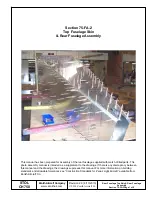
Jabiru Aircraft
SECTION 4
CASA APPROVED
Model J160-C
NORMAL PROCEDURES
JP-FM-06
Revision:
0
1
2
3
1 Dec 2008
Page
4-10
4.5.6
Before Take-Off
Warm Up
Most of the warm up will have occurred during taxiing and whilst conducting the Before Take-Off
checks. The engine is warm enough for take-off when the cylinder head and oil temperatures are in
the green arcs.
Ignition System Check
The magneto check should be made at 2000 RPM as indicated by the tachometer with the
carburettor heat set to COLD. Select the LEFT ignition OFF and note the RPM drop, return to
BOTH until the engine regains speed. Select RIGHT ignition OFF and note the RPM drop, return
to BOTH. Drop in RPM should not exceed 100 RPM. Do not operate on a single ignition source for
an extended period; a few seconds is usually sufficient to check RPM drop and will minimise spark
plug fouling.
4.5.7
Take-Off
Power Check
Full throttle runups over loose gravel are especially harmful to the propeller and should be avoided.
When take-offs must be made from a gravel surface, it is very important that the throttle be
advanced slowly and a rolling start take-off technique be used to minimise propeller damage.
It is important to check full throttle engine performance early in the take-off run. Any sign of rough
engine operation or sluggish acceleration is good cause for discontinuing the take-off and
conducting a full power runup to confirm normal engine operation prior to the next take-off attempt.
Wing Flap and Power Settings
Normal take-offs are accomplished at full throttle, and TAKE-OFF flap selected. The flaps should
not be retracted until a safe height is achieved and all obstacles have been cleared. Take-offs may
be made with flaps up but this will increase the take-off distance and will result in a more
pronounced nose up attitude at lift off.
4.5.8
Climb
Initial climb
Initial climb is performed with flaps up full throttle 71 KIAS.
Enroute climb
Enroute climbs are performed with flaps up, full throttle, and at speeds 5 to 10 knots higher than the
initial scheduled climb speed. This provides better engine cooling with little loss of climb
performance.
Summary of Contents for J160-C
Page 2: ...This page intentionally left blank...
Page 3: ......
Page 5: ...This page intentionally left blank...
Page 7: ...This page intentionally left blank...
Page 9: ...This page intentionally left blank...
















































